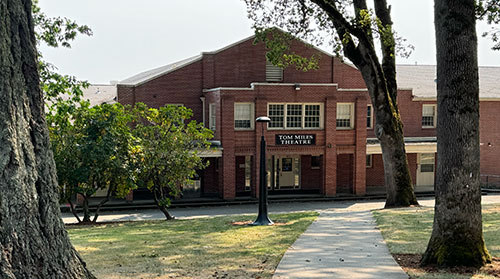 A challenge in impromptu playwriting and performance opens Pacific University’s Fall 2024 theatre and dance performance schedule.
A challenge in impromptu playwriting and performance opens Pacific University’s Fall 2024 theatre and dance performance schedule.
The Instant Theatre Festival on Saturday, Sept. 14 will be the first of four fall performance dates for the department. The theatre program’s fall stage production, "The Lantern of Jack," will include four performances from Oct. 24 to 27.
Pacific’s dance program will present two performances during the holiday season. The Autumn Choreographers Concert will take place from Nov. 21 to 23. The fall schedule concludes with the Holiday Informal on Friday, Dec. 6.
All performances are open to the community and take place in the Tom Miles Theatre in Warner Hall on Pacific University’s Forest Grove Campus unless noted.
Saturday, Sept. 14: Instant Theatre Festival, 6:30 p.m., Various Locations
Think of it as speed-dating for theatre. The 2024-25 season begins with a playwriting challenge open to current students and alumni. On Friday, Sept. 13, participating playwrights will receive a prompt for a 10-minute play and will write through the night. The next morning, the playwrights hand their scripts off to directors, who will rehearse with actors in preparation for performances on Saturday evening.
Admission to the Instant Theatre Festival performances is free. Attendees will gather at 6:30 p.m., Saturday, Sept. 14, on the patio outside of Warner Hall and travel together to performance locations across campus.
Oct. 24-27: The Lantern Of Jack
Oct. 24, 25 & 26 at 7:30 p.m., Oct. 27 at 2 p.m.
A love letter to autumnal folklore, "The Lantern of Jack" embraces both the darkness and light of the season, told through a series of stories, devised and performed by our brilliant student theatre artists.
Tickets are free for Pacific students and $5 for community members and will be available for purchase soon on the Pacific Theatre & Dance Department website. American Sign Language interpretation will be provided at the Oct. 27 performance.
Nov. 21-23: Autumn Choreographers Concert
Nov. 21 & 22 at 7:30 p.m., Nov. 23 at 2 p.m.
Pacific celebrates the season with its annual Autumn Choreographers Concert. This year’s program features five senior dance majors presenting their capstone projects in research choreography and dance film. In addition, Portland-based guest choreographer Taylor Eddleston completes a guest residency to set a new work on Pacific’s pre-professional university dance company, Pacific Dance Ensemble (founded in 2004), along with faculty-created works to culminate an eclectic evening of dance.
Tickets are $5 for Pacific students, staff and alumni, and $8 for general admission and will be available for purchase later this fall on the Pacific University Theatre & Dance Department website.
Fri., Dec. 6: Dance Department Holiday Informal, 6 p.m.
Kick off the holiday season with Pacific University Dance’s Holiday Informal Performance. This informal event offers students and faculty the opportunity to highlight and present the incredible creative work over the semester, with presentations from fall semester dance classes and original holiday-themed works created by Pacific’s talented dance students. Admission to this performance is free.